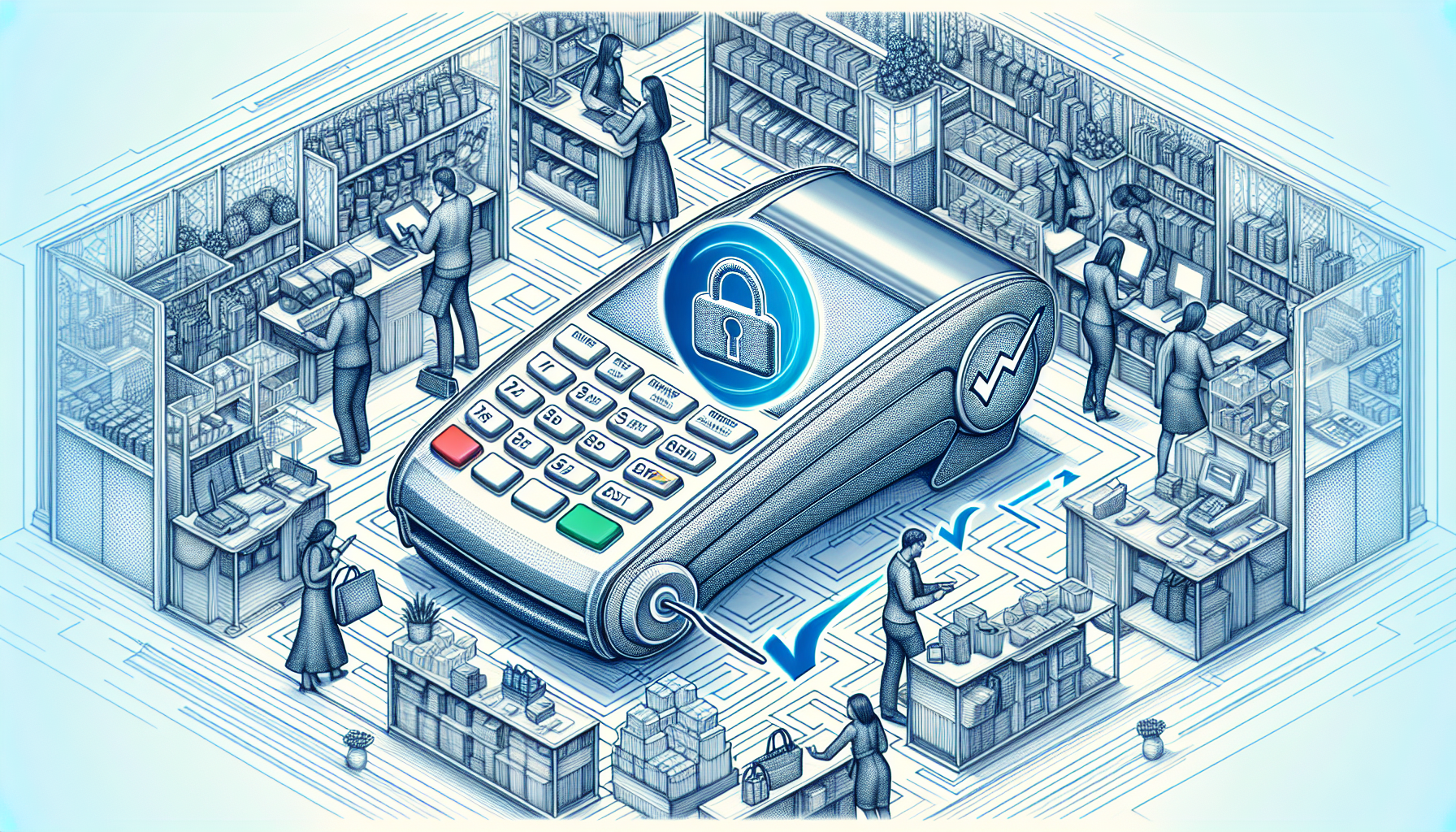EMV Terminals
EMV Terminal Solutions
If you accept card payments, you need an EMV terminal. Designed to thwart fraud and comply with payment security standards, EMV terminals are crucial for safe transactions. Our guide explains their functionality, benefits, and how to choose one that fits your business needs, equipping you with the knowledge to make an informed decision.
Key Takeaways
- EMV technology, managed by EMVCo, has become the global standard for secure transactions, reducing the vulnerabilities prevalent with magnetic stripe cards through features like offline PIN verification and encryption.
- Compliance with EMV standards is crucial for merchants to reduce liability for fraudulent card-present transactions, with the liability shift post-October 2015 making non-compliant merchants potentially responsible for such fraud.
- The integration of EMV terminals with mobile payments, like NMI’s ‘Tap on Phone’ technology, and the support for NFC, offers businesses a way to modernize their POS systems and enhance customer payment experience.


The Evolution of EMV Technology and Terminals
Born out of a need to combat the vulnerabilities of magnetic stripe cards, EMV technology has grown to become a global standard for secure transactions. The development of EMV, short for Europay, Mastercard, and Visa, was primarily aimed at addressing issues with counterfeit magnetic strip cards and lost or stolen cards, offering an alternative to signature-based verification.
One of the significant enhancements of this technology was the capability of offline PIN verification, reducing reliance on online transaction authorizations. Today, EMVCo, a consortium of major financial companies, manages the EMV standard, ensuring its continued evolution and application across the globe.
The Rise of Chip Cards
EMV chip cards, also known as emv cards, or simply called chip cards, are standard bank cards with an embedded microcomputer chip. They store card data identical to the magnetic stripe and are designed to prevent credit card fraud. The adoption of chip and pin cards saw a significant surge in France in 1992, reducing the French market’s online authorization rate from 40% to about 10%. To further enhance security, businesses should accept EMV chip cards.
EMV transactions, powered by EMV technology, enhance security for online transactions through:
- PIN
- electronic signatures
- dynamic authentication
- encryption of transaction data
The widespread adoption of EMV technology has played a significant role in reducing point-of-sale crime worldwide, demonstrating the transformative potential of this technology.
EMV Terminals: The New Standard
EMV terminals stand as the vanguard of transaction security. They leverage encryption and dynamic data authentication to securely process chip card payments. This shift to EMV technology has led to a significant reduction in counterfeit card fraud, solidifying the effectiveness of EMV terminals.
Merchants and credit card companies worldwide have recognized the necessity of adopting EMV terminals, making the requisite investment to protect their customers and reduce liability for fraudulent transactions. Financial institutions have been instrumental in promoting EMV technology and its widespread adoption, leading to a more secure payment landscape.

Understanding Your EMV Terminal
An EMV terminal goes beyond simply processing card payments. It is a complex system that incorporates various steps including card insertion, cardholder verification, and transaction authorization, each designed to ensure the safety and security of the transaction. The data stored in these terminals is in BER TLV format on smart cards, a secure and efficient way of handling information.
Evaluating the legitimacy of the cardholder is a key element of the EMV transaction process and a critical measure in fighting fraudulent transactions. To further enhance security, card issuer and script processing allows card issuers to send commands to the card, updating it post issuance for continued security and proper function.
The Components of an EMV Terminal
EMV terminals are composed of multiple components and features, all designed to fortify transaction security and efficiency. These terminals employ security features such as encryption and tokenization to protect transaction data. When selecting EMV terminals, merchants must consider hardware options, including secure checkout counter devices and customer-facing PIN pads, as well as terminal functionality like touchscreen interfaces and receipt printing capabilities.
With the rise of mobile POS solutions, EMV card readers often come pre-certified with major processors, eliminating the need for developers to undergo additional certifications.
The Process Behind Chip Transactions
The process of an EMV chip transaction is a harmonious blend of secure and efficient operations. EMV terminals process chip card payments by interacting with the card’s embedded chip to create a unique code for each transaction, enhancing the security of the payment process. The terminal initiates the process by:
- Sending a get processing options command
- The card responds with the application interchange profile (AIP) and application file locator (AFL)
- The generation of the ARQC
- The terminal conducting CVM and risk management checks.
Processing restrictions during an EMV transaction involve checking the application version number, application usage control, and application effective/expiration dates. Achieving EMV compliance ensures the encryption of customer card details, adopting global standards for secure payment transactions, and protecting data significantly, reducing fraud risks.
Navigating the Liability Shift with EMV Compliance
The introduction of EMV technology led to a significant liability shift for fraudulent card-present transactions. This liability shift transferred the responsibility from issuing banks to merchants who do not have EMV-compatible payment terminals. Since October 2015, merchants in the United States could be held liable for fraudulent transactions if they did not upgrade to EMV-compatible terminals.
This shift in liability has placed a greater emphasis on EMV compliance, offering benefits such as reduced liability for fraudulent charges and the maintenance of customer trust by securing cardholder data during transactions.
Understanding Fraud Liability Shifts
To incentivize the adoption of EMV technology and reduce fraud, a liability shift was implemented. This shift meant that merchants who have not upgraded to EMV-compliant payment terminals may experience increased liability for fraudulent transactions. However, merchants are shielded from liability for fraudulent EMV card transactions when proper fallback procedures are followed, and the credit card issuers approve the otherwise fraudulent transaction.
In cases where a counterfeit or stolen EMV chip card is used at a terminal that cannot process the chip, the liability for fraud typically shifts to the acquiring bank and the merchant.
Steps to Achieve EMV Compliance
Attaining EMV compliance is an essential measure for businesses to safeguard themselves from liability for fraudulent transactions. Small businesses can achieve this compliance by adopting EMV-compliant card readers and incorporating point-to-point encryption, alongside ensuring that staff are fully trained in card security protocols.
To make this upgrade more accessible, financing options are available for businesses that can help alleviate the financial burden of upgrading to EMV-compliant systems.
EMV Terminals and Mobile Payments

Merging EMV terminals with mobile payments signifies an exciting advancement in secure, convenient transactions. Businesses are encouraged to adopt EMV-compliant contactless payment options, which include mobile EMV solutions. Through partnerships like the one between NMI and Mastercard, technological solutions such as ‘Tap on Phone’ are enabling smartphones to be used as EMV-enabled point-of-sale systems.
By adding mobile payment platforms like Apple Pay and Google Pay to ecommerce platforms, businesses can enrich consumer checkout processes. This integration offers merchants the ability to accept contactless payments on-the-go, increasing convenience for both the merchant and their customers.
Enhancing Security with Mobile EMV Readers
Mobile EMV card reader devices play a crucial role in securing transactions and expanding payment capabilities. Mobile SDKs provided by companies like NMI enable developers to build comprehensive mobile point-of-sale applications that support secure EMV payment card acceptance. Transactions with mobile EMV readers are encrypted, providing protection against data cloning and tampering.
Merchants can enhance their point-of-sale systems by leveraging software-based EMV POS terminals on mobile devices, adding flexibility to their operations. Mobile EMV readers connect with smartphones or tablets via Bluetooth, offering a portable solution that meets modern commerce needs. The wide adoption of EMV technology enables seamless integration with various payment options, including contactless cards, catering to different consumer preferences.
The addition of near-field communication (NFC) peripherals to EMV setups facilitates wireless transactions, further expanding secure payment capabilities.
The Compatibility of EMV with Supported Devices
EMV terminals are engineered to work with a variety of devices such as smartphones, tablets, and conventional checkout systems. To ensure secure transactions, EMV terminals utilize technologies such as end-to-end encryption and tokenization when interacting with supported devices.
EMV payment processing offers several benefits:
- Efficient and quick transaction times
- Convenience, irrespective of the device used for the transaction
- Support for contactless payments through devices equipped with NFC technology, broadening device compatibility.
Streamlining Operations with EMV POS Systems

Incorporating EMV terminals into point-of-sale (POS) systems can substantially enhance business operations’ efficiency. EMV POS systems provide hardware solutions that comply with industry standards, ensuring the safety and efficiency of transactions. By integrating these systems into their operations, businesses can optimize their daily activities, enabling them to focus on their core offerings.
The Role of EMV Terminals in POS Transactions
EMV terminals play a crucial role in POS transactions. Modern POS terminals read the card’s EMV chip, authenticate the transaction, and issue a digital or printed receipt. During a transaction, customers are prompted by pin terminal to either insert or tap their card, and may need to enter a PIN or provide a signature. Countertop terminals are equipped with features like WiFi, NFC, and printers, suitable for basic EMV payment processing.
Mobile wireless terminals enable EMV payment processing on the go, meeting the needs of industries like restaurants. Smart terminals blend POS system utilities with terminal functionality, including hybrid card readers and built-in printers. By streamlining the bank approval process and handling transactions with low average sale amounts and minimal chargebacks, EMV terminals support a range of businesses.
Simplifying Payment Processing with EMV Solutions
The use of EMV solutions can greatly simplify payment processing and enhance security. Vector Payments offers a user-friendly payment processing platform that integrates with business tools for simplified transactions. The platform supports additional capabilities, addressing strategic business needs for innovation.
Merchants receive EMV-compliant card readers from Vector Payments featuring advanced encryption and authentication technology to secure payment processes. By undertaking a cost analysis with Vector Payments, businesses can transform payments into a strategic tool for innovation and revenue growth.
Choosing the Right EMV Terminal for Your Business

Selecting the appropriate EMV terminal is a vital decision for every business. The terminal must be selected based on the specific needs of the business, with consideration given to transaction types and frequency.
The variety of EMV terminals available today means that businesses have a range of options to choose from, each offering its unique set of features and benefits.
Factors to Consider When Selecting an EMV Terminal
Multiple factors influence the selection of an EMV terminal. Some key considerations include:
- Compatibility with the business’s current payment processor and software to avoid integration issues
- Support for connectivity options that fit the business environment, such as Wi-Fi, Ethernet, or cellular networks
- Features such as touchscreen interfaces and receipt printing
The security features offered by EMV terminals, which help protect against fraud, are a critical factor in the selection process. Consideration must also be given to the overall cost and setup, including the need for a separate countertop terminal for credit card transactions if pin pads are used for debit payments.
Why Expert Advice Matters
Expert guidance is indispensable in choosing the right EMV terminal. It ensures that the chosen product is compatible with the business’s unique needs. Vector Payments, with its commitment to delivering exceptional customer service and continuous support, can help businesses make informed decisions about their EMV terminal needs. Leveraging over 30 years of experience in payment processing, Vector Payments assists both low and high risk industries with navigating terminal selection and processing concerns.
Businesses may consider top EMV terminal brands such as Verifone, Ingenico, and PAX Technology, and obtaining guidance from payment processing experts like Vector Payments can aid in selecting the most suitable model.
Maximizing Savings with Vector Payments
By using Vector Payments’ side-by-side cost savings analysis, businesses can optimize their savings. This analysis assists businesses in reducing their processing fees, helping them to operate more cost-effectively.
To receive a tailored cost savings analysis, businesses simply need to submit their previous month’s processing statement to Vector Payments and can benefit from this analytical service the same day.
The Advantage of Cost Analysis
Vector Payments provides a service that performs a same-day side-by-side cost savings analysis, enabling merchants to quickly scrutinize their processing statements and spot potential savings areas.
This analysis can provide valuable insights into the business’s payment processing operations, highlighting areas where cost savings can be achieved.
Customized Solutions for Every Merchant
Vector Payments is committed to personalized service and support for each high risk merchant client. They offer:
- Low risk pricing options tailored for high risk merchants
- A unique solution that caters to the specific needs of these businesses
- Expertise in managing high-risk merchant accounts without imposing the typical high-risk price tag
This sets them apart in the industry.
Summary
In conclusion, EMV technology has revolutionized the landscape of secure payment processing. From its origins as a solution to combat the vulnerabilities of magnetic stripe cards, it has grown into a global standard for secure transactions. Whether you’re a small business owner or part of a large corporation, understanding and integrating EMV technology into your operations can enhance transaction security, streamline operations, and unlock potential cost savings. With the guidance of experts like Vector Payments, businesses can navigate the world of EMV technology with confidence, selecting the right EMV reader and terminal, achieving EMV compliance, and maximizing savings.
If you are ready to talk about your current EMV, contact us today!
Frequently Asked Questions
What is EMV technology?
EMV technology is a global standard for credit and debit payment cards, based on chip card technology, which enhances transaction security and reduces the risk of fraud.
How do EMV terminals work?
EMV terminals work by interacting with the embedded chip in a chip card to create a unique transaction code, which improves payment security.
What is the EMV liability shift?
The EMV liability shift transfers the responsibility for fraudulent card-present transactions from issuing banks to merchants without EMV-compatible payment terminals. This means that merchants are now liable for any fraudulent transactions if they take contact cards that do not have EMV technology.
How can businesses achieve EMV compliance?
To achieve EMV compliance, businesses should adopt EMV-compliant card readers, implement point-to-point encryption, and ensure staff are trained in card security protocols. This is crucial for protecting customer data and reducing the risk of fraud.
What are the benefits of a side-by-side cost savings analysis provided by Vector Payments?
A side-by-side cost savings analysis provided by Vector Payments allows merchants to easily review their processing statements and identify potential areas for savings. It is a helpful tool for maximizing cost efficiency in payment processing.
